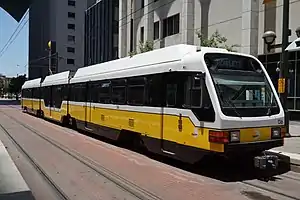Kinki Sharyo SLRV
The Kinki Sharyo Super Light Rail Vehicle (SLRV) is a light rail vehicle manufactured by Kinki Sharyo, operated by Dallas Area Rapid Transit (DART), and modified jointly by the two companies.[5][6]
| Kinki Sharyo SLRV | |
|---|---|
 | |
 | |
| Manufacturer | Kinki Sharyo |
| Entered service | 2010 |
| Number built | 163 |
| Capacity | 94 passengers (seated), 274 (crush load) per car[1] |
| Operator(s) | DART |
| Specifications | |
| Car body construction | Low alloy high tensile steel |
| Train length | 494 ft (150.57 m) over couplers (four articulated cars coupled together; maximum train length) |
| Car length | 123 ft 8 in (37.69 m)[1] over couplers. The length of a three-section, articulated car |
| Width | 8.83 ft (2.69 m)[1] |
| Height | 12.9 ft (3.93 m)[1] |
| Floor height | Low floor: 16 in (40.64 cm) High floor: 39.5 in (100.33 cm) |
| Entry | Level boarding and steps |
| Doors | Sliding pocket type; 5 per side[2] |
| Articulated sections | 3; designated A, B and C |
| Wheelbase | Motor: 84 in (213.4 cm) Trailer: 70 in (177.8 cm) |
| Maximum speed | 70 mph (110 km/h)[3] |
| Acceleration | 2.3 mph/s (3.4 ft/s2; 1.0 m/s2) |
| Deceleration | 3 mph/s (4.4 ft/s2; 1.3 m/s2) |
| Train heating | Yes |
| Electric system(s) | 750 V DC catenary |
| Current collection method | Pantograph |
| Notes | |
| [4] | |
Description
The SLRVs are longer and can accommodate more passengers than the Kinki Sharyo-built vehicles from which they were developed, known by DART as its standard Light Rail Vehicles (LRVs),[5] which had been operated by DART Light Rail since it began service in June 1996.[7] DART's original LRVs were built as articulated, two-section cars with operator cabs at both ends.[6]
The SLRVs were designed to both increase passenger capacity and to improve the accessibility of DART's light rail system.[8] Each three-section, articulated SLRV measures 123.5 ft (37.64 m) over couplers, while the maximum train length is four articulated cars coupled together, measuring 494 ft (150.57 m) over couplers in total.[4] An individual SLRV is 31 feet (9.4 m) longer and 33,000 pounds (15,000 kg) heavier than the standard LRVs from which they were developed, which were each 92 feet 8 inches (28.24 m) in length and weighed 107,000 pounds (49,000 kg).[5] The SLRVs have a maximum speed of 70 mph (110 km/h) and can accelerate at a rate of 2.3 mph/s (3.4 ft/s2; 1.0 m/s2).[4]
Partnership
Working in partnership, DART and Kinki Sharyo created the SLRVs by separating the existing two-section LRVs at their articulation joints and inserting an entirely new section in between,[5][9] thereby rendering them three-section vehicles.[10] The resulting SLRVs are double-articulated, eight-axle cars, in comparison to the single-articulated, six-axle design of the original LRVs.[7] Each SLRV seats 98 passengers and can accommodate roughly 100 more standing passengers, which allows it to accommodate approximately 25 more seated people (and roughly 50 more overall) than a standard, two-section LRV.[4][5]
The middle section, variously called "Body C",[6] "C Unit", or "C Car",[11] has a low floor and provides step-free access to the SLRV.[11] It was designed primarily to allow passengers in wheelchairs,[11] as well as those with strollers and bicycles, to embark and disembark more quickly and safely.[5][6] Each SLRV middle section is also equipped with a bicycle rack.[6]
Prototype
In 2002, the prototype SLRV, car #170, began operating on DART's Blue Line. On June 23, 2008, car #151 became the first SLRV to enter revenue service. DART converted all 115 of its LRVs into SLRVs at a total cost of approximately $190 million,[5] which was more cost effective than buying entirely new light rail vehicles.[5][9] G. James Morgan of LTK Engineering Services estimated that DART saved over $50 million by converting its LRVs instead of buying new accessible vehicles.[7]
Conversion of an individual LRV into an SLRV took roughly five weeks,[5][7] with a sixth week for inspection and testing and the vehicle in main line operation by the next week.[7] By March 2010, 84 of DART's 115 LRVs had been converted into SLRVs,[7] and by August 2014, DART was operating a total of 163 SLRVs: all 115 converted LRVs in addition to 48 new vehicles.[4][10]
DART also modified its light rail platforms between 2007 and 2010 to accommodate the greater overall length and low-floor middle sections of the SLRVs.[9]
References
- "Dallas Area Rapid Transit Reference Book" (PDF). Dallas Area Rapid Transit. March 2018. Retrieved August 2, 2018.
- "DART Rail Facts". Retrieved 2019-01-27.
- "Kinkisharyo SLRV Technical Data Sheet" (PDF). Retrieved 2019-07-04.
- "Dallas-Dallas Area Rapid Transit Technical Data" (PDF). Kinkisharyo International, LLC. Archived from the original (PDF) on June 15, 2016. Retrieved March 19, 2016.
- "Super Light Rail Vehicles (SLRV) Facts". Dallas Area Rapid Transit. October 29, 2010. Retrieved June 5, 2016.
- Nakazawa, Akihisa. "DART: Dallas Area Rapid Transit" (PDF). Kinkisharyo International, LLC. Retrieved June 5, 2016.
- Morgan, G. James. "DART Super Light Rail Vehicles Low Floor Center Section: The Final "Successful" Chapter" (PDF). LTK Engineering Services. Retrieved June 5, 2016.
- "Success Stories: Dallas Area Rapid Transit". Kinkisharyo International, LLC. Retrieved June 5, 2016.
- Lew, Alexander (June 25, 2008). "Dallas Introduces "Super Light Rail Vehicles"". Wired. Retrieved June 5, 2016.
- Dixon, Scott (August 24, 2014). "Japanese companies ride U.S. light rail boom". The Japan Times. Retrieved June 5, 2016.
- Latham, Garl (2006). "Rapidly Improving Transportation". Progressive Engineer. Archived from the original on January 26, 2015. Retrieved June 5, 2016.